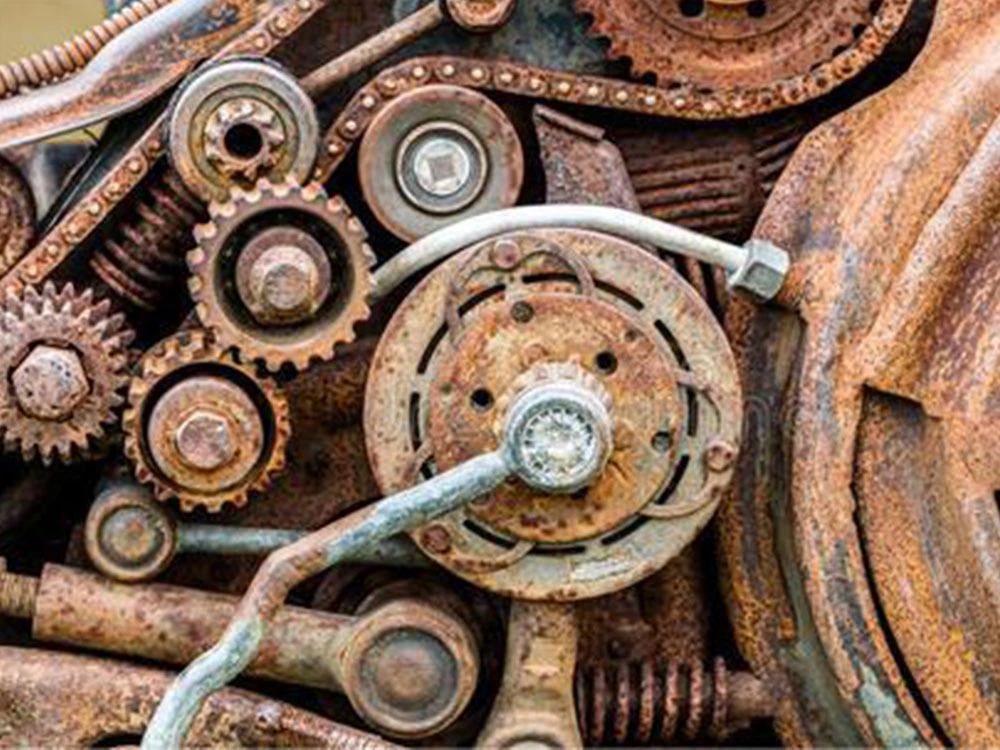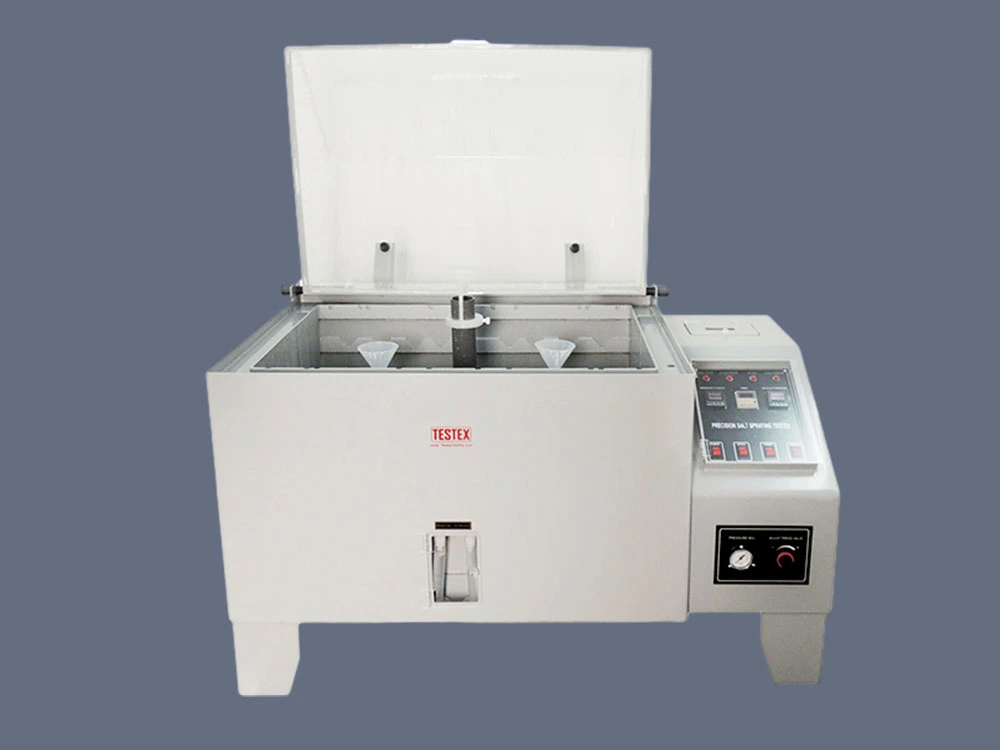Salt spray testing is a used method for assessing the metal’s corrosion resistance. It simulates salt spray erosion in ocean air conditions. Thus the corrosion resistance of metal materials to assessed.
Metal salt spray corrosion test standards
Metal salt spray test standards include international standards, national standards, and industry standards. ISO 9227 “corrosion of metals and alloys – salt spray test” is one of the most representative standards. The standard specifies the salt spray test equipment, specimen preparation, and other content. It provides a unified specification and guidance for salt spray testing of metals.
Metal salt spray corrosion test process
Specimen preparation:
Select appropriate metal materials. According to the standard for the preparation of specimens into the specified size. The specimen surface should be flat, with no oil, no oxide, and other defects.
Equipment preparation:
Salt spray test equipment including salt spray test chamber, spray device, and so on. Before testing, the instrument requires cleaning and calibration. It assures the test conditions are accurate and stable.
Test condition setting:
According to the standard, set the temperature, humidity, salt solution concentration, etc. Normally, the salt spray test is controlled at a temperature of about 35℃. The concentration of salt solution is about 5%.
Test process:
Put the prepared specimen into the salt spray test chamber. According to the set test conditions for the salt spray corrosion test. Test time according to the standard requirements. Generally from 24 hours to several weeks.
The end of the test and specimen processing:
After the end of the test, the specimen is removed from the salt spray test chamber. Observe the corrosion, record the degree of corrosion and morphology, and other characteristics.
Metal salt spray corrosion test results interpretation
The results of the metal salt spray test are assessed by the degree and appearance of corrosion. Common corrosion morphology includes pitting, crevice corrosion, intergranular corrosion, and so on. Depending on the degree of corrosion, the results can be categorized into different grades. Such as slight corrosion, moderate corrosion, and severe corrosion.
In interpreting the results, the below should be noted:
Comparison of standards:
Compare the test results with the corrosion levels specified in the standard. Determine the corrosion resistance level of the specimen.
Consider the test conditions:
Differences in test conditions can affect the results. There is a need to take into account the coherence and comparability of the test conditions.
Combined with practical applications:
Salt spray corrosion testing of metals is only a simulated test method. The results do not represent the corrosion situation in the actual use environment. Thus, it needs to be considered in conjunction with the actual application scenarios.
Metal salt spray testing is an effective method of metal corrosion resistance assessment. It has a major function in the development, production, and application of metals.Through understanding the standards, processes, and results of metal salt spray corrosion testing. Enables a better assessment of the resistance of metallic materials to erosion. Provide strong support for the selection and application of materials.
Salt spray corrosion hazards
- Salt spray erosion damages the protection coating of the metals. It renders it non-decorative and less mechanically strong.
- Electronic components and electrical appliances cause power line interruption due to corrosion. Especially in the environment with vibration, especially serious.
- When salt spray lands on the surface of the insulator, it will reduce the surface resistance. An insulator reduces its power resistance by four orders of size when it soaks up a salt mixture.
- Corrosives increase friction on moving parts. This causes mechanical parts or moving parts to seize.
Salt spray corrosion test for metal materials
The salt spray test is divided into a natural environment test and an artificially accelerated simulation test. The latter involves the use of a salt spray tester to produce a salt fog condition. Thus, the quality of the product’s salt spray corrosion resistance is assessed.
Salt concentrations are several or tens of times higher than the natural conditions. It results in higher erosion rates and a much shorter time to obtain results. If tested in a naturally exposed condition, it could take up to 1 year to corrode them. Artificial simulation salt spray tests can give similar results in just 24 hours. However, artificially sped-up simulated tests are still dissimilar to natural conditions. Thus, artificially accelerated simulation tests can not replace the natural environment.
Scope of application
- Copper+Nickel+Chromium or Nickel+Chromium plating on steel surface;
- Copper or copper alloy face plated with chromium + nickel;
- Plated with chromium + nickel on 400 series or 300 series stainless steel;
- Plating of nickel + copper + chromium on aluminium or aluminium alloys;
- Chrome+ Copper+Nickel plated on zinc alloy face;
- Plastic plated parts.
Influencing factors
1) Test temperature and Humidity
Temperature and relative humidity impact the erosion efficacy of salt spray. The metal corrosion upper limit of relative humidity is around 70%. Above the limit, salt forms an electrolyte. Until the precipitation of crystalline salt, the corrosion speed is lowered accordingly. The greater the test temp, the quicker the salt spray erosion speed. For the neutral salt spray test, the temperature selected at 35 ℃ is more appropriate.
2) Concentration of Salt Solution
The concentration of salt solution on the corrosion rate of the impact of the material and the type of cover layer. The erosion speed of steel, nickel, and brass increases by concentration below 5%.At concentrations higher than 5 percent, the erosion speed of the metals reduces as the concentration rises.
3) Sample Placement Angle
The angle at which the sample is placed has a major impact on the salt spray test results. The salt spray settles in a direction near upright. The specimen has the biggest projection field if it is put horizontally. The face of the specimen is also subjected to the largest mass of salt spray, and the corrosion is the most critical. The GB/T2423.17-93 standard specifies the “method of placing the specimen horizontally”. The test surface should be made at an angle of 30°from the vertical.
Results judgement
The salt spray test aims to evaluate the quality of a metal’s resistance to salt spray corrosion. The salt spray test outcome is the criterion for the quality of the goods. Whether the results of its judgment are correct and reasonable, is the key to measuring the quality of products or metal salt spray corrosion resistance.
1) Grade evaluation method:
The percentage of corroded space to the total space is classified into several grades. Judgment is based on a specified level. It is suited to the assessment of plane specimens.
2) Method of determination by weighing:
Judgment is made by the change in weight of the specimen before and after the erosion test. Count the lost weight to determine the quality of the specimen’s corrosion resistance. It is suitable for a metal corrosion quality assessment.

3) Corrosive appearance determination method:
It is a qualitative judgment method. It is a specimen for judging whether or not a product is showing corrosion. Usually, product standards largely apply this way.
4) Statistical analysis of corrosion data:
Mainly used to analyze, statistical corrosion. Not a judgment dedicated to the quality of a particular product.
Common salt spray corrosion phenomenon
① Normal face corrosion
Uniform dislodgement of material over the complete material-corrosive interface. It is a quite frequent kind of corrosion. A common type of sheet corrosion is surface corrosion.
② Pitting corrosion (pore corrosion)
Corrosion medium on a limited localized erosion. Piercing the material causes pores or craters. Its depth is nearly ever larger than its diameter. Virtually no metal is removed from the surface outside the pitting corrosion zone. Pitting corrosion is usually due to halogenated ionic.
③ Crack Corrosion
Corrosion happens mostly in narrow crevices. This is due to the difference in concentration of the erosion medium. For example, the outcome of excessively long O2 spreading pathways.This type of corrosion so that the potential difference between the two ends of the crevice. This leads to increased corrosion in poorly ventilated areas.
④ Dezincification
Zinc is selectively dissolved from the brass, leaving a porous purple copper organization. The processes of nickel and aluminum removal are similar.
⑤Rust
Formation of ortho-iron oxide and hydroxide erosion products from steel.
⑥ Loss of luster
The surface of an object becomes less lustrous.
Summarising
Different metal plating layers have different requirements for salt spray corrosion tests. The salt spray test time for galvanized, chromium-plated, and other coatings is shorter. At the same time, the test time for aluminum and nickel plating may be longer. This is due to the different anti-corrosion properties of different metal coatings. Thus it needs to be evaluated and tested on a case-by-case basis.
Salt spray test results are usually judged by the degree of corrosion and weight loss on the surface. Less corrosion or less weight loss indicates better corrosion resistance of the metal. Specific judgement criteria can be determined according to the relevant norms, standards requirements.
Salt spray corrosion tests can detect the corrosion resistance of metal plating. It offers a science-based for the design and improvement of metal coatings. Simulating the marine environment speeds up the metal coatings’ corrosion rate. It helps manufacturers to assess the corrosion resistance of plated surfaces. Thus optimizing the plating process and material selection.
For more environmental test chamber, Please visit: https://chiuventionclimatechamber.com
For more environmental test simulation programmes,environmental testing knowledge, instrument knowledge, and environmental testing laboratory knowledge, please contact us: [email protected]

